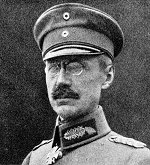This article needs additional citations for verification .(December 2021) |
You can help expand this article with text translated from the corresponding article in German. (December 2021)Click [show] for important translation instructions.
|
Albert von Berrer | |
|---|---|
 | |
| Born | 8 September 1857 Unterkochen, Kingdom of Württemberg |
| Died | 28 October 1917 (aged 60) San Gottardo, Kingdom of Italy |
| Allegiance | |
| Branch | |
| Years of service | 1874–1917 |
| Rank | Generalleutnant |
| Unit | 31st Infantry Division 51st Corps |
| Battles / wars | World War I |
| Awards | Pour le Mérite |
Albert von Berrer was a Generalleutnant of Imperial German Army who was involved in World War I. He was killed in action in late 1917.